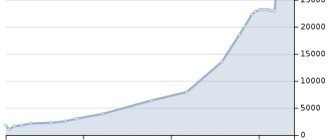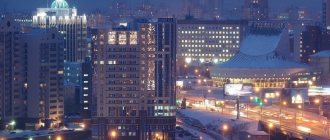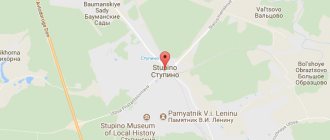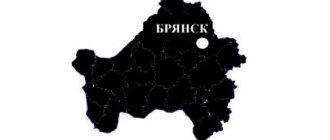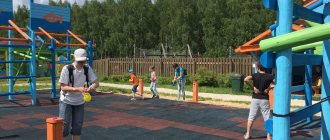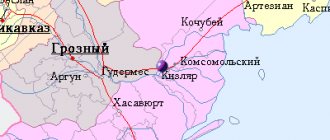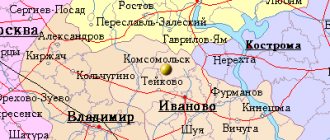For the hockey player from Russia, see Artyom Lukoyanov.
City in Nizhny Novgorod region, Russia
| Lukoyanov Lukoyanov | |
| Town[1] | |
| Bridge over the Khvoshchevka River in Lukoyanov | |
| Coat of arms | |
| Location of Lukoyanov | |
| Lukoyanov Location of Lukoyanov Show map of Russia Lukoyanov Lukoyanov (Nizhny Novgorod region) Show map of Nizhny Novgorod region | |
| Coordinates: 55°02′N 44°29'E / 55.033°N Latitude 44.483°E / 55.033; 44.483Coordinates: 55°02′N 44°29'E / 55.033°N Latitude 44.483°E / 55.033; 44.483 | |
| A country | Russia |
| Federal subject | Nizhny Novgorod region[1] |
| Administrative region | Lukoyanovsky district[1] |
| City of district significance | Lukoyanov[1] |
| Based | 16th century |
| City status from | 1779 |
| population (2010 Census)[2] | |
| • General | 14,951 |
| • Evaluate (2018)[3] | 14,104 (-5.7%) |
| Administrative status | |
| • Capital from | Lukoyanovsky district[1], city of district significance Lukoyanov[1] |
| Municipal status | |
| • Municipal district | Lukoyanovsky municipal district[4] |
| • Urban village | Lukoyanov urban settlement[4] |
| • Capital from | Lukoyanovsky municipal district[4], urban-type settlement Lukoyanov[4] |
| Timezone | UTC + 3 (MSK [5]) |
| Postal code(s)[6] | 607800, 607802, 607849 |
| OKTMO I WOULD | 22639101001 |
| Web site | www.luk-of.RU |
Lukoyanov
(Russian: Lukoyanov) is a town and the administrative center of Lukoyanovsky District in Nizhny Novgorod Oblast, Russia, located on the Tesha River, 173 km (107 mi) south of Nizhny Novgorod, the administrative center of the region. Population: 14,951 (2010 Census);[2]12,856 (2002 Census);[7]12,276 (1989 Census).[8]
City of LUKOYAN official website www.luk-of.ru
The city of Lukoyanov, along with other 477 settlements in the country, is classified as a historical city of the Russian Federation (annex to the Federal Target Program “Preservation and Development of the Architecture of Historical Cities” (2002-2010).
A settlement on the site of modern Lukoyanov arose in the 16th century around the Ivashki Lukoyanov
near the low-water rivers Khvoshchevka and Teshe.
The village of Lukoyanov grew, changed owners many times, until at the beginning of the 18th century it was transferred to the category of economic villages.
Lukoyanov received the status of a full-time city - a district center of the Nizhny Novgorod governorship on September 5, 1779, following the administrative reform of Empress Catherine
II.
The coat of arms of Lukoyanov - in the upper part the Nizhny Novgorod coat of arms - “in a white field there is a red deer, horns and black hooves”, in the lower part - “two golden ploughshares in a green field, meaning the abundant grain production of the local places” - was approved on August 16, 1781.
the Trinity Fair established in 1863 , it quickly became the economic and trade center of the south of the Nizhny Novgorod province.
On July 1, 1782, the first geometric plan for the city's development was approved. Sergei Stepanovich Shebarshin was involved in the development of Lukoyanov’s master plan .
“In 1817, after a fire, the district administration was transferred to the village. Madaevo and the district were renamed Madayevsky, but in 1820 Lukoyanov was again made a district town. By January 1, 1895, there were 1,917 inhabitants (1,015 men and 902 women): 12 nobles, 20 honorary citizens and merchants, 918 bourgeois, 951 peasants, 16 other classes. Orthodox 1,785, schismatics 96, Mohammedans 22, Jews 6, etc. confessions 8. Churches - 2, women's community; 2-class city men's, 2-class women's and parochial schools. The zemstvo has a hospital and a pharmacy in Lukoyanov. Simplified city management. City revenues are 9196 rubles, expenses are 9082 rubles, including for city administration 3130 rubles, for public education 180 rubles, for medical services 110 rubles. Some public places (for example, zemstvo government, military presence) are located not in Lukoyanov, but in the provincial town of Pochinki "(Encyclopedic Dictionary of F.A. Brockhaus and I.A. Efron)
.
In 1818-1820, Lukoyanov was rebuilt in accordance with the general plan. The first brick buildings—temples—began to appear in the city. The first to be built was a floor (cemetery) church in honor of the Kazan Icon of the Mother of God (1821). Intercession Cathedral began on the central square , designed by the famous architect Mikhail Petrovich Korinfsky. In 1826, the majestic, beautiful Cathedral of the Intercession of the Most Holy Theotokos was consecrated for services. According to legend, its bells were cast with the addition of silver, which gave them a special “raspberry” sound.
On November 13, 1827, the first men's district school , with a dozen students - mostly children of merchants, and one teacher - a priest. Later the school began to expand. Around 1840, with the direct participation of the district mayor Nikolai Ivanovich Rusinov a women's school was opened in the city . Its graduates became teachers in the first district schools.
In 1869,
the Lukoyanovsky district bank . The provincial assembly allocated 10 thousand rubles for its establishment. Banking services were used by merchants, artisans and even the growing rich peasantry. For the city's centenary, in 1879, the bank allocated part of the savings received from interest for the construction of a building for a higher primary city four-year school for boys. In 1874, a postal and telegraph office - the city was connected by telegraph to Arzamas and Nizhny Novgorod. On March 12, 1884, a parochial one-class school .
In 1905, the dilapidated wooden church building was rebuilt into a stone one. In 1885, the Tikhonovskaya convent . It was organized by the daughter of the titular councilor Anna Nikiforovna Listova , who bought a plot of land with an area of 1.5 hectares on the corner of modern Gorky and Kumanev streets. In 1867, a house church was built here, consecrated in honor of the wonderworker Tikhon of Zadonsk. In 1887, the Holy Synod approved the creation of a women's community in Lukoyanov, and in 1896 it transformed it into a third-class Tikhonovsky convent. Mother Asenefa was appointed abbess and then abbess of the monastery . For ten years, from 1896 to 1906, with donations from patrons and money from ordinary townspeople, a three-altar cathedral was erected in the monastery, the abbess's house, a school building, an icon-painting room, a sewing room, a choir room, a bread building, a hospital building, and other outbuildings were built. There was a parochial school for girls at the monastery. The number of nuns in some years reached up to 150. In 1929, the Tikhonovskaya Church was closed, the nuns began to be evicted, and in 1931 the monastery buildings were destroyed.
Lukoyanov in the twentieth century
At the beginning of the twentieth century, the city had 4 lower educational institutions, with 165 boys and 139 girls studying, a library with 22 subscriptions, a reading room with 500 readers, a printing house, and a zemstvo hospital with 41 beds, staffed by two doctors and two midwives. There was a flour-grinding and steam plant and 108 craft establishments.
In 1903, at
the Lukoyanovskaya district prison , located on what is now Chkalov Street, a church was built in honor of the icon of the Most Holy Theotokos “Seeking the Dead.” People called it Ostrozhskaya. The first priest was P.I. Nartsisov. In the spring of 1905, a local Social Democratic group . Its core consisted of workers at the railway junction. During the First World Revolution, they organized rallies, produced and distributed leaflets. On December 12, 1905, Lukoyanov’s railway workers, as a sign of solidarity with the rebel workers of Moscow, began an indefinite strike. For more than two weeks no locomotives left the depot. In 1910, a women's gymnasium , which two years later was transformed into a gymnasium. The secondary educational institution provided not only general, but also professional training - for home teachers and teachers for zemstvo schools. The gymnasium existed until 1918. The outbreak of the First World War seriously affected the condition of the city and county. General mobilization began. Thousands of Lukoyanovites fought on the fronts. The railway workers switched to working under the military regime. Every day trains with manpower and equipment went through the station to the front. From police reports it is known that along the way the mobilized destroyed shops, stores, and landowners' estates. In 1914, the first cinema , with a small film distribution office attached to it. The building was built by local timber merchant Lavrov. On July 21, the cinema hosted the first screening of the film “Defense of Sevastopol.” The news of the bourgeois-democratic revolution that had taken place in Petrograd came to Lukoyanov on February 27, 1917. The railway workers organized a demonstration, marching through the city with red banners and slogans “Down with the war!”, “Long live the revolution!” At the same time, a Bolshevik party organization was created in Lukoyanov. Its ideological leader was a member of the RSDP(b), depot mechanic Ivan Dmitrievich Kabakov. a temporary executive committee was formed . It included: L. A. Rusinov - chairman of the district zemstvo government, L. P. Borisov - city commandant, colonel, N. M. Urvantsev - city elder, M. V. Sakharov - member of the district court. The committee developed a declaration calling on the population to obey the laws and act within the framework of order and tranquility. The protection of law and order was entrusted to the police officer F. G. Feltisov. On October 9, 1917, in the city, in the house of the merchants Chivkunovs, the Nikolaev men's gymnasium . Its director was Ivan Mikhailovich Golan . In 1918, the gymnasium was reformed into a second-level school, and then into the Lukoyanovsky Soviet School No. 1 . Alexander Alexandrovich Zerchaninov , who later became a prominent philologist and author of a textbook on Russian literature, was appointed its director Afterwards the director of the school was Pavel Vasilievich Titkov , who also became a scientist, a member of the editorial board of the Great Soviet Encyclopedia, deputy.
Minister of Education of the RSFSR. On October 26 (November 8, new style), 1917, workers at the Lukoyanov station railway junction received a telegram from the revolutionary headquarters of the Bolsheviks of the Moscow-Kazan Railway about the victory of the armed uprising in Petrograd. The formation of new power structures began in the city. A Red Army detachment was created under the command of S. Dolenko . The Supreme body of power became the Council of Workers' Deputies.
During the years 1918-1920, 66 mobilizations into the Red Army were carried out in the city and district: almost two-thirds of the male population were on the fronts of the Civil War.
In 1918, the first kindergarten (it was located in the house of the Lavrov merchants , now it is the building of the local history museum) and an orphanage for street children and orphans named after. Karl Marx (in the house of the merchant Karpov, today's city administration building).
In the same year, the garrison club-theater "Red October" , located in a converted trading building of the merchant Korolev (later given over to the House of Pioneers - the House of Children's Creativity).
In 1918-1937 there was
a Lukoyanovsky diocese . By order of the Patriarch of Moscow and All Rus' Tikhon, Bishop of Lukoyanovsky, Polycarp, was appointed, later replaced by Seraphim, who was both bishop and vicar of Lukoyanovsky. In the summer of 1923, the Gorn cinema , and on July 6, 1926, the railway workers’ club opened. In the summer of 1927, a radio center began operating. On February 1, 1929, the Mordovian Pedagogical College (now the Lukoyanovsky Pedagogical College named after A. M. Gorky) opened in the city.
Its first director was V.P. Kiushov. On September 2, 1929, a state archive . The first archivist was V. S. Sysoev.
In the spring of 1929, the first tractor drove through the city streets. The people perceived this event with excitement: some were baptized, some were hiding, and some stood as if spellbound... Only the boys ran after the “iron horse” looking at it with curiosity. And already on November 8, 1930, a machine and tractor station opened in Lukoyanov. (In March 1958 it was reorganized into a repair and technical station, and in 1997 into OJSC Selkhoztekhnika).
In 1931,
a repair and technical workshop , which was engaged in the repair of agricultural equipment. In 1934 it was renamed the Lukoyanov Machine and Tractor Workshop (MTS). In the same year, Lukoyanovskaya MTS was recognized as one of the best in the region and was included in the Regional Board of Honor. Since 1961, the company has operated as Avtoremzavod, specializing in the repair of GAZ-69 vehicles and GAZ-51 engines. Since January 1988, the company has been renamed AvtoUAZremont and has been repairing UAZ vehicles and their engines. In 1932, a poultry farming college , which existed until the 50s. In 1937 - Lukoyanov Medical School (now Lukoyanov Medical College).
In 1932, several single artisans: N.A. Ushenkin, the Kondakov and Filippov brothers formed the “Handicraft” artel . The artel was engaged in tailoring. In the early 50s, the industrial artel began to be called the “Red Textile Worker”. Now it is a large Russian enterprise, OJSC Work Wear.
In 1938, the first stage of the city water supply system came into operation.
During the Great Patriotic War, many enterprises in the city switched to producing military products. The Salmox sewing industry supplied thousands of sets of winter and summer uniforms to the front - sweatshirts, tunics, trousers, and underwear. Sewing workers were also tasked with making the first army shoulder straps. The “Red Textile Worker” artel produced camouflage netting, and the “Kustar” produced a metal barrier net against submarines. Lukoyanov's railway workers ensured the uninterrupted delivery of military cargo to the front. Women's tractor brigades were formed under the MTS. In 1941, a fighter battalion was formed in the city, I. N. Martynov was appointed its commander, and A. N. Klimov was appointed chief of staff. In 1943, courses for telephone operators for the front were organized. Captain Ermolaev, who was awarded the Order of the Red Banner of Battle for his participation in the Civil War, was appointed their leader.
In 1941-1945, 6 evacuation hospitals were located in Lukoyanov, located in the buildings of a hospital, a House of Culture, school No. 1 and a basic school, a pedagogical school, and an agricultural technical school dormitory.
Each hospital housed up to 600 wounded soldiers. The head of the hospitals was A.V. Sveshnikov. During the war, there was an orphanage for children taken from besieged Leningrad. In 1943, school No. 2 . I.V. Irsetsky was appointed its director . In the same year, the Lukoyanovsky vocational school was formed to train tractor drivers and drivers for enterprises in the region. At first these were short-term courses, after the war the duration of training was increased to several months. In 1951, a society for the blind . Visually impaired people have the opportunity to work and receive wages. Until 1959, they were engaged in wet production, then stamping caps, and in recent years (late 80s-90s) manufacturing electrical circuits for the automotive industry. In 1953-58, a man-made grove was founded, subsequently named in honor of its founder A.F. Magnitsky. In 1954, a seasonal brick factory with a capacity of 1.1 million pieces per year was opened in Lukoyanov in the upper part of the city. In 1974 it was liquidated due to wear and tear of the equipment. On November 3, 1958, the Lukoyanovskaya electrical substation was connected to the state energy system: the city's enterprises received industrial current. In 1962, a cold storage facility , which was later transformed into the Lukoyanovsky meat processing plant. In 1963, according to statistics, 6 thousand 900 people lived in the city. In May 1965, an obelisk was unveiled on Peace Square in memory of Lukoyanovites who died during the Great Patriotic War. On December 19, 1965, a ball bearing plant . In 1967, the most modern skim milk powder plant . The plant was engaged in receiving and shipping whole milk, and since 1973 it switched to dairy production. In 1992, the company was incorporated. Currently not working. From December 15, 1967, with the signing of the order of the deputy. Minister of Internal Affairs, corrective labor colony No. 20 . Yu. N. Korotaev was appointed its first head. In January 1968, the construction organization PMK-515 was created in the city. One of the largest in the region. In 1970, a gas pipeline . The Lukoyanovsky department of the Gorky Regional Gas Administration was created. The first gas distribution station was built at the exit from the village. Kudeyarovo. One household gas line stretches towards the city, the other towards the village of Ulyanovo. On November 2, 1971, clay gravel plant with a capacity of 200 thousand cubic meters of products per year came into operation.
In the same year, a new brick factory was put into operation.
In 1976, the Lukoyanovsky
house-building plant , one of the largest in the region, began producing its products. Construction of city microdistrict No. 2 began. On February 1, 1989, an Employment Bureau was formed in Lukoyanov, now the Employment Center. In August 1991, Metropolitan Kirill of Smolensk and Kaliningrad , now the Patriarch of Moscow and All Russia, visited the city on a private visit. He blessed the revival of the Church of the Intercession of the Virgin Mary and sent 100 thousand rubles for its construction. Construction of the temple began in 1995. On December 25, 1992, a television tower was launched in Lukoyanov. This is the tallest television tower in the region, its height is 250 meters. In 1997, 15 thousand 200 people lived in the city. On February 19, 2004, the Charter of the city of Lukoyanov was adopted. In February 2008, a service began in the built church in honor of the Intercession of the Virgin Mary . On August 2, 2010, the temple was consecrated by Patriarch Kirill of Moscow and All Russia, who came specially for this purpose. In September 2009, the city of Lukoyanov celebrated its 230th anniversary.
(based on materials from the book: Lukoyanovsky Our Land. Issue 2: Historical Reference Book, 2009)
Links[edit]
Notes[edit]
- ^ abcdefgh Order No. 3-od
- ^ a b Federal State Statistics Service (2011). “All-Russian Population Census 2010. Volume 1" [All-Russian Population Census 2010, vol. 1]. All-Russian Population Census 2010 [All-Russian Population Census 2010]
. Federal State Statistics Service. - "26. The size of the permanent population of the Russian Federation by municipalities as of January 1, 2022". Federal State Statistics Service. Retrieved January 23, 2022.
- ^ abcde Law No. 162-Z
- "On the Calculation of Time". Official Internet portal of legal information
. June 3, 2011. Retrieved January 19, 2022. - Post office. Information and computing center of OASU RPO. ( Post office
).
Search for postal service objects ( postal Search for objects
) (in Russian) - ↑
Federal State Statistics Service of Russia (May 21, 2004).
“The population of Russia, the constituent entities of the Russian Federation as part of federal districts, urban settlements, settlements, settlements of 3 thousand or more people” [Population of Russia, its federal districts, federal districts, districts, urban settlements, rural settlements - administrative centers and rural settlements with a population of more than 3,000 people] (XLS). All-Russian Population Census 2002
. - “All-Union Population Census of 1989. The current population of union and autonomous republics, autonomous regions and districts, territories, effects, urban settlements and rural district centers” [All-Union Population Census of 1989: current population of union and autonomous republics, Autonomous regions and districts, territories, regions, districts, urban settlements and villages performing the functions of district administrative centers. All-Union Population Census of 1989 [All-Union Population Census of 1989]
.
Institute of Demography of the National Research University: Higher School of Economics [Institute of Demography of the National Research University: Higher School of Economics]. 1989 - via Demoscope Weekly
.
Map
| Lukoyanov: maps |
Lukoyanov: photo from space (Google Maps) Lukoyanov: photo from space (Microsoft Virtual Earth)
| Lukoyanov. Nearest cities. Distances in km. on the map (in brackets along roads) + direction. Using the hyperlink in the distance , you can get the route (information courtesy of the AutoTransInfo website) | |||
| 1 | Shaky | 27 (30) | NW |
| 2 | Gagino | 41 (42) | NE |
| 3 | Pochinki | 44 (54) | SE |
| 4 | Pervomaisk | 47 (56) | Z |
| 5 | Bolshoye Boldino | 53 (77) | IN |
| 6 | Arzamas | 58 (63) | NW |
| 7 | In hell | 58 (89) | WITH |
| 8 | Outcall | 59 (66) | NW |
| 9 | Elniki (Republic of Mordovia) | 60 (88) | SW |
| 10 | Kemlya (Republic of Mordovia) | 61 (193) | SE |
| 11 | Transportation | 63 (109) | WITH |
| 12 | Buturlino | 64 (87) | NE |
| 13 | Bolshoye Ignatovo (Republic of Mordovia) | 69 (237) | IN |
| 14 | Sarov | 75 (87) | Z |
| 15 | Diveevo | 78 (95) | Z |
| 16 | Krasnoslobodsk | 80 (117) | SW |
| 17 | Old Shaigovo (Republic of Mordovia) | 81 () | YU |
| 18 | Urazovka | 82 (96) | NE |
| 19 | Sergach | 83 (87) | NE |
| 20 | Bolshoye Murashkino | 85 (115) | WITH |
| 21 | Romodanovo (Republic of Mordovia) | 88 (159) | SE |
| 22 | Far Konstantinovo | 89 (115) | WITH |
| 23 | Ardatov | 90 (115) | Z |
| 24 | Sechenovo | 92 (116) | IN |
| 25 | Lyambir (Republic of Mordovia) | 92 (146) | SE |
| 26 | Temnikov | 92 (150) | SW |
| 27 | Knyaginino | 93 (130) | WITH |
| 28 | Gremyachevo | 100 (117) | NW |
| 29 | Saransk | 104 (132) | SE |
| 30 | Pilna | 107 (116) | NE |
a brief description of
Located on the bank of the river. Tesha (tributary of the Oka), 173 km southeast of Nizhny Novgorod. Railway station.
Territory (sq. km): 57
Information about the city of Lukoyanov on the Russian Wikipedia site
Historical sketch
In the 16th century a certain Ivashka Lukoyanov built a mill, thus laying the foundation for the village of Lukoyanov. From the middle of the 17th century. economic village.
Since 1779, the district town of Lukoyanov, Nizhny Novgorod governorship (since 1796 - Nizhny Novgorod province).
In 1856, in the district town of Lukoyanov, Nizhny Novgorod province, there were 2 churches, 440 houses, 5 shops.
Economy
Bearing repair and expanded clay plants. House-building plant.
In the Lukoyanovsky district, rye, wheat, barley, oats, sugar beets, and fodder crops are grown. They raise cattle, pigs, and sheep.
Deposits: titanium-zirconium sands, Kurleevskoye rare earth metals, Merlinovskoye expanded clay clay, Razinskoye stone-wattle fence, building stone and sands, as well as peat.
Culture, science, education
Museum of Local Lore (in the former house of the Blokhins, second half of the 19th century, wooden).
Architecture, sights
Magnitsky Grove (founded in 1953). Areas of oak forests are the remains of ancient Murom forests, Morzhovsky sacred groves “Lukash”, “Yavlei”, “Kshekuravai”. The Razin stone, under which, according to legend, the treasures of Stepan Razin are buried.
| Population by year (thousands of inhabitants) | |||||||
| 1856 | 2.9 | 1992 | 12.2 | 2007 | 12.5 | 2016 | 14.2 |
| 1897 | 2.1 | 1996 | 11.8 | 2008 | 12.4 | 2017 | 14.1 |
| 1931 | 7.5 | 1998 | 11.5 | 2010 | 12.3 | 2018 | 14.1 |
| 1939 | 5.5 | 2000 | 11.3 | 2011 | 15.0 | 2019 | 13.9 |
| 1959 | 7.0 | 2001 | 11.2 | 2012 | 14.8 | 2020 | 13.8 |
| 1970 | 10.2 | 2003 | 12.9 | 2013 | 14.5 | 2021 | 13.6 |
| 1979 | 11.4 | 2005 | 12.7 | 2014 | 14.3 | ||
| 1989 | 12.3 | 2006 | 12.6 | 2015 | 14.2 | ||
